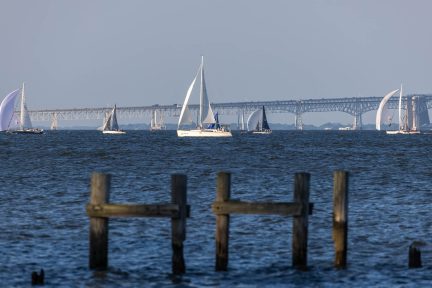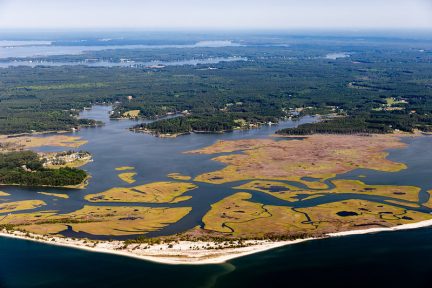Chesapeake Bay Program reports decline in underwater grass abundance
Chesapeake Bay Program reports decline in underwater grass abundance
In 2019, an estimated 66,387 acres of underwater grasses were mapped in the Chesapeake Bay and its tidal tributaries, achieving 36% of the Chesapeake Bay Program’s ultimate restoration goal of 185,000 acres.
Although the 66,387 acres mapped in 2019 are a 70% increase from the 38,958 acres observed during the first survey in 1984, it is a 17% decrease from the preceding 10-year average of 79,738 acres and a 38% decrease from 2018 when it was estimated that the Bay may have supported up to 108,078 acres of underwater grasses. Many factors prevented complete mapping of underwater grass acres in 2018 which resulted in an estimate calculated by combining mapped acreage with 2017 data for the region that was not mapped to estimate the acreage in the Bay.
In 2019, the largest decline in terms of total area—an estimated 34,986 acres—was observed in moderately salty waters, particularly in the Tangier Sound area, which experienced a 18,452-acre decline. Experts attribute the losses largely to a decline in widgeon grass. Widgeon grass fluctuates from year-to-year as the species responds rapidly to impacts from extreme weather or changes in water quality. The decline in widgeon grass that we saw in 2019 mirrors a similar situation that occurred in 2001-2003, where a rapid increase in widgeon grass in 2001 and 2002 was followed by a 50% decline in 2003. Though the precise cause for the decline in 2019 is unknown, higher than average river flows may have contributed by reducing water clarity and blocking sunlight from reaching the grasses.
Underwater grass abundance can vary from species to species and river to river. In 2019, local highlights included:
- Northeast Maryland: Underwater grass abundance in the Sassafras River increased from 162 acres in 2018 to 405 acres in 2019.
- Central Maryland: Underwater grass abundance in the Severn River increased from 224 acres in 2018 to 404 acres in 2019; in the neighboring Magothy River it increased from 36 acres in 2018 to 183 acres 2019.
- Southeast Virginia: Underwater grass abundance in the middle and upper Rappahannock River increased from 1,007 acres in 2018 to 1,453 acres in 2019. In the upper tidal fresh portion of the James River, underwater grass abundance increased from 402 acres in 2018 to 536 acres in 2019, while in the Chickahominy River it increased from 711 acres in 2018 to 1,059 acres in 2019.
- Lower central Chesapeake Bay: In the Maryland portion of the lower central Chesapeake Bay, underwater grass abundance declined from 2,669 acres in 2018 to 901 acres in 2019. Underwater grass abundance in the Virginia portion of the lower central Chesapeake Bay declined from 2,719 acres in 2018 to 583 acres in 2019.
The Chesapeake Bay Program recently brought together experts specializing in underwater grasses, water quality, and land-use research and management to develop a series of fact sheets that examines the role that a growing human population—and its associated impacts—plays on the Bay’s grass beds. Each fact sheet gives a close-up view of what’s happening in each of the rivers across the Bay in order to provide a summary of information to guide local planning decisions and implementation of best management practices that encourage underwater grass recovery. These facts sheets can be found at https://gis.chesapeakebay.net/sav/.
To learn more about our progress toward achieving and sustaining 185,000 acres of underwater grasses Bay-wide, visit ChesapeakeProgress.
Facts
In 2019, an estimated 66,387 acres of underwater grasses were mapped in the Chesapeake Bay and its tidal tributaries: 51% of the Chesapeake Bay Program’s 2025 restoration target of 130,000 acres and 36% of the partnership’s 185,000-acre goal. This is a 38% decrease from 2018 when it was estimated that the Bay may have supported up to 108,078 acres of underwater grasses.
Tracking Bay grasses by salinity zone:
Experts reported the following changes in the Bay’s four salinity zones between 2018 and 2019:
- Bay grass abundance in the Bay’s fresh waters (Tidal Fresh Salinity Zone) decreased from an estimated 19,051* acres to 17,577 acres, achieving 85% of the zone’s 20,602-acre goal.
- Bay grass abundance in the Bay’s slightly salty waters (Oligohaline Salinity Zone) increased from an estimated 7,901* acres to 9,014 acres, achieving 87% of the zone’s 10,334-acre goal.
- Bay grass abundance in the Bay’s moderately salty waters (Mesohaline Salinity Zone) decreased from an estimated 62,933* acres to 27,947 acres, achieving 23% of the zone’s 120,306-acre goal.
- Bay grass abundance in the Bay’s very salty waters (Polyhaline Salinity Zone) decreased from an estimated 18,192 acres to 11,849 acres, achieving 35% of the zone’s 33,647-acre goal.
*These areas were not fully mapped in 2018 due to weather conditions and highly turbid water.
Issues
Like grasses on land, underwater grasses need sunlight to survive. When the waters of the Chesapeake Bay become clouded with algae blooms or suspended sediment, sunlight cannot reach the bottom habitat where these grasses grow. While healthy grass beds can trap and absorb some nutrient and sediment pollution— thus improving water clarity where they grow—too much pollution can cause grass beds to die off. High water temperatures, turbulence from strong storms and drought can also affect the growth and survival of underwater grass beds. Chesapeake Bay Program partners are working to improve water clarity, protect and restore grass beds, enhance bay grass monitoring and research and expand education and outreach to restore underwater grasses and boost their habitat benefits in the watershed.
Importance
Underwater grasses—also known as submerged aquatic vegetation or SAV—are critical to the Chesapeake Bay ecosystem. They keep our waters clean by absorbing excess nutrients, trapping suspended sediment and slowing wave action that helps to stabilize shorelines, protect wetlands and reduce erosion. Bay grasses also provide food for small invertebrates and migratory waterfowl and habitat for fish and blue crabs. In fact, bay grass abundance is one of several factors that can impact the health and stability of the blue crab population: the loss of these grasses is a loss of nursery habitat which can increase their vulnerability by pushing young crabs to gather in the limited nurseries that remain.
The 2020 Blue Crab Advisory Report found that the overall blue crab population in the Bay decreased from 594 million in 2019 to 405 million in 2020. While this marks a 31% decrease from the previous year, experts report the overall Chesapeake Bay blue crab population is not depleted or being overfished. An estimated 61 million pounds of blue crabs were commercially harvested from the Chesapeake Bay in 2019, which is below the 1990-2018 averages. Recreational crabbers harvested roughly 3.8 million pounds in 2019, similar to the 2018 harvest estimate of 3.4 million pounds.
Because bay grasses are sensitive to climate conditions and pollution but quick to respond to water quality improvements, their abundance is a good indicator of Bay health. To support the resurgence of underwater grass beds in the Bay, cities and towns can reduce polluted runoff and upgrade wastewater treatment plants with pollution-reducing technologies, farmers can use conservation practices to keep fertilizers in their fields, boaters can steer clear of bay grass beds that are growing in shallow waters, waterfront landowners can limit hardened shorelines where possible and homeowners can use rain barrels or rain gardens to slow the delivery of nutrient- and sediment-laden stormwater runoff into the Bay.
Quotes
“The past two years have tested the resilience that our SAV beds have been building since the Chesapeake Bay pollution diet was implemented. The good news is that many of the Bay's tributaries stood up well against the high flows and associated sediment and nutrient runoff from 2018 and 2019, and SAV acreage even continued to expand in some. But there's still much more work to do in order to mitigate unpredictable impacts from climate change. The Chesapeake Bay Program and its partners are committed to that effort and will continue working toward improving water quality and reversing these recent losses.”
- Brooke Landry, Chair, Chesapeake Bay Program SAV Workgroup and Natural Resource Biologist, Department of Natural Resources, State of Maryland
“Just looking at the total numbers for Chesapeake Bay SAV, last year was a tough year. The losses we witnessed erased the gains that we’ve observed over the preceding several years. However, it’s important to remember that this is a dynamic ecosystem with natural variation in SAV coverage from year to year. When you place 2019 in the context the decades of data we have collected, you can see that we remain on a positive trajectory. Going forward it is important that we stay the course and continue to work across the watershed to reduce nutrient pollution and restore this fantastic ecosystem.”
- Chris Patrick, Head of the Chesapeake Bay SAV Monitoring and Restoration Program and Assistant Professor of Biology, Virginia Institute of Marine Science, College of William and Mary
“While it is disappointing to see a decline in SAV acreage this past year, I also see this as an opportunity to refocus our efforts on the restoration and protection of SAV beds. SAV plays a critical role in our local waterways and in the fight for swimmable, fishable rivers. We have the capability to reach our SAV acreage by improving water quality and being better stewards of our land.”
- Elle Bassett, Miles-Wye Riverkeeper, ShoreRivers



